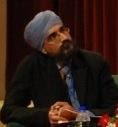THE importance of Waqf, an important institution in Islamic wealth management, was the topic of discussion during a roundtable on the development of Waqf properties In Malaysia.
The
speakers during the event held at the Sasana Kijang in Kuala Lumpur, were
unanimous in stating their agreement that with effective administration and
implementation, the institution of Waqf has great spiritual and economic
potential.
“I
think most of us today are in agreement that the Waqf with effective
administration and implementation, has great spiritual and economic potential,”
said INCEIF president & CEO, Daud Vicary Abdullah.
Vicary
said the outcome of the roundtable “could be significant and timely in charting
the way forward for the management of Waqf properties.”
“I
am confident that we should be able to galvanise our combined knowledge and
experience towards that end. We may not be able to find all the answers to our
questions today, but it certainly will be a significant start.” Vicary said
during his introduction speech.
Ministry
of Finance secretary general of Treasury Tan Sri Dr Mohd Irwan Serigar
Abdullah, in a speech read during the event, recalled that on Sept 28, 2012,
Malaysian Prime Minister Datuk Seri Mohd Najib Razak, in his Budget 2013
speech, announced that the Malaysia Waqf Foundation will be responsible for
formulating the Corporate Waqf Master Plan taking into consideration the State
Islamic Religious Council Legislative Structure.
“Furthermore,
in 2013 the prime minister announced that the Malaysia Waqf Foundation will be
turned into a corporate Waqf entity to optimise the value and benefit of
nonfinancial assets such as property for Muslims.
“Following
both the announcements, the Malaysia Waqf Foundation proposed to establish a
wholly owned subsidiary to conduct business activity and undertake
Shariah-compliant investment.” Mohd Irwan said.
Malaysia,
which is home to a large number of Waqf properties, stands to benefit from a
concerted effort to develop the properties to their full potential.
An
example of the proper management of Waqf property, which was turned into a
revenue generating enterprise, is the Bank Islam Malaysia Bhd building in the
golden triangle of Kuala Lumpur.
The
joint venture formed between Bank Islam and Tabung Haji Technologies Sdn Bhd
for the building of a 34-storey premium office tower on Waqf land, and agreed
by the Kuala Lumpur Islamic Religious Council.
The
building is on the most strategic Waqf land in terms of location and value in
Kuala Lumpur, situated in the vicinity of the Petronas TwinTowers. Though the
land is a Waqf land stipulated for charity purposes with a status of public
Waqf, the commercial building developed on the buildoperate-transfer concept,
benefits the owners.
The
roundtable was told, by the various speakers, that the concept could be used to
encourage families to “Waqf” their land in a bid to benefit from commercial
arrangements, thus turning the Waqf instrument into a wealth management
solution.
Tabung
Haji will manage the building, completed in 2010, for 25 years with a RM56.6
million lease payment to the council, while Bank Islam is the anchor tenant.
In
Malaysia, the developers of Waqf land faced a setback due to lack of access to
financial support, and the ground breaking project between the KL Waqf council
and Bank Islam could spearhead the development of other such projects.
The
entire project is seen as a landmark commercial development using the Waqf
instruments, as well as an example of Waqf success in driving major investment
portfolios from other financial institutions for future ventures, wrote
Salobiah Mokhtar in a dissertation on developing Waqf properties, on theacademia.edu
website. — The Malaysian Reserve, 29 Jan 2014


No comments:
Post a Comment